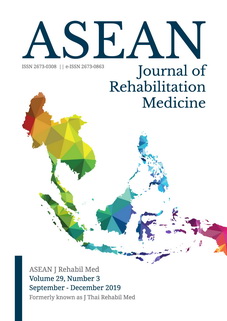Effects of Kinesiotaping Combined with Medial Arch Support on Reduction of Heel Pain from Plantar Fasciitis: A Randomized Controlled Trial and Single-blinded
Keywords:
ปวดเท้า, ปวดส้นเท้า, พังผืดใต้ฝ่าเท้าอักเสบ, การติดเทปเพื่อบำบัด, อุปกรณ์พยุงอุ้งเท้าAbstract
Objectives: To evaluate an effect on heel pain reduction of kinesiotaping combined with medial arch support in patients with plantar fasciitis.
Study design: Randomized controlled trial, single blinded.
Setting: Department of Rehabilitation Medicine, Faculty of Medicine, Siriraj Hospital.
Subject: Patients aged 18 years old or more with plantar fasciitis and unilateral heel pain at least one month of moderate pain.
Methods: All patients were treated with a medial arch support, and a stretched-kinesiotaping in the experimental group (25 patients) whereas a non-stretched kinesiotaping in the control group (24 patients). After a week of the combined treatment, all were asked to continue wearing shoes and slippers with a medial arch support until the end of the study. All patients rated their first-step foot pain in the morning with NRS before and after treatment at day 3, 7 and at the end of 6 weeks. Pressure pain threshold (PPT) at the heel was evaluated with a pressure algometer, and complications of kinesiotaping were recorded.
Results: Demographic data and NRS of foot pain before treatment were no differences between groups. Comparing with the baseline data, in both groups the pain scores at day 3, day 7 and at 6 weeks decreased significantly (p < 0.001), and the PPT increased decreased significantly at day 7 (p < 0.001). However, there were no differences in foot pain and the PPT between groups. No serious complications of kinesiotaping were reported.
Conclusion: Applying either stretched or non-stretched kinesiotaping for a week had no additional effect on pain reduction in treating plantar fasciitis with a medial arch support. Medial arch supports alone could decrease pain in plantar fasciitis when applied for 6 weeks.
References
2. Biju C, Ifthikar A, Madhusmita K, Abhijit D. A comparative study on effectiveness of taping with iontophoresis and taping alone in chronic plantar fasciitis. Int J Physiother. 2016;3:238-41.
3. Buchbinder R. Plantar fasciitis. N Engl J Med. 2004;350:2159-66.
4. Hansen L, Krogh TP, Ellingsen T, Bolvig L, Fredberg U. Long term prognosis of plantar fasciitis A 5 to 15 year follow-up study of 174 patients with ultrasound examination, Orthop J Sports Med. 2018;6:1-9.
5. Peerbooms JC, Van LW, Faber F, Schuller HM, Van HH, Gosens T. Use of platelet rich plasma to treat plantar fasciitis: design of a multi-center randomized controlled trial. BMC Musculoskelet Disord. 2010;11:69.
6. Goff JD, Crawford R. Diagnosis and treatment of plantar fasciitis. Am Fam Physician. 2011;84:676-82.
7. Benedict FD, Deborah AN, Marc EL, Elizabeth AM, Joseph CM, Gregory EW, et al. Tissue-specific plantar fascia-stretching exercise enhances outcomes in patients with chronic heel pain. A prospective, randomized study. J Bone Joint Surg Am. 2003;85:1270-7.
8. Benedict FD, Deborah AN, Daniel PM, Petra AG, Taryn TW, Gregory EW, et al. Plantar fascia-specific stretching exercise improves outcomes in patients with chronic plantar fasciitis. A prospective clinical trial with two-year follow-up. J Bone Joint Surg Am. 2006; 88:1775-81.
9. Hyland MR, Webber-Gaffney A, Cohen L, Lichtman PT. Randomized controlled trial of calcaneal taping, sham taping, and plantar fascia stretching for the short-term management of plantar heel pain. J Orthop Sports Phys Ther. 2006;36:364-71.
10. Osborne HR, Allison GT. Treatment of plantar fasciitis by low dye taping and iontophoresis: short term results of a double blinded, randomised, placebo controlled clinical trial of dexamethasone and acetic acid. Br J Sports Med. 2006;40:545-9.
11. Weil LS, Roukis TS, Weil LS, Borrelli AH. Extracorporeal shock wave therapy for the treatment of chronic plantar fasciitis: indications, protocol, intermediate results, and a comparison of results to fasciotomy. J Foot Ankle Surg. 2002;41:166-72.
12. Thammawijaya A, Assawapalangchai S. The study of the effects of a custom-molded medial arch support made from silicone in patients with plantar fasciitis. J Thai Rehabil Med 2013;23:87-93.
13. Baldassin V, Gomes CR, Beraldo PS. Effectiveness of prefabricated and customized foot orthoses madefrom low-cost foam for noncomplicated plantar fasciitis: arandomized controlled trial. Arch Phys Med Rehabil. 2009;90:701-6.
14. Gramatikova M. Kinesiotaping effect on edema of knee joint. Res Kinesiology. 2015;43:220-3.
15. Windisch C, Brodt S, Rohner E, Matziolis G. Effects of kinesiotaping compared to arterio-venous impulse system on limb swelling and skin temperature after total knee arthroplasty. Int Orthop. 2017;41:301-7.
16. Chang HY, Wang CH, Chou KY, Cheng SC. Could forearm kinesiotaping improve strength force sense and pain in baseball pitchers with medial epicondylitis. Clin J Sport Med. 2012;22:327-33.
17. Kalron A, Bar-sela S. A systematic review of the effectiveness of kinesiotaping - fact or fashion. Eur J Phys Rehabil Med. 2013;49: 699-709.
18. Tulasi R, Praveen D, Prasad V, Rakhee KP. Effect of kinesiotaping in adjunct to conventional therapy in reducing pain and improving functional ability in individuals with plantar fasciitis- A randomized controlled trial. Int J Physiother. 2015;2:587-93
19. Tsai CT, Chang WD, Lee JP. Effects of short-term treatment with kinesiotaping for plantar fasciitis. J Musculoskelet Pain. 2010;18: 71-80
20. Budiman Mak E, Conrad KJ, Roach KE. The foot function index: a measure of foot pain and disability. J Clin Epidemiol.1991;44: 561-70.
21. Yu Konishi. Tactile stimulation with kinesiology tape alleviates muscle weakness attributable to attenuation of Ia afferents. J Sci Med Sport. 2013;16:45-8.






